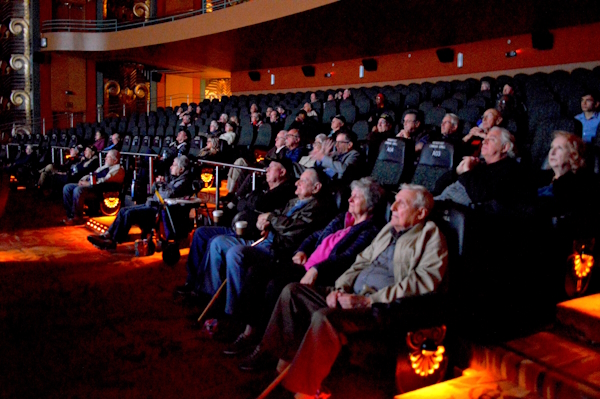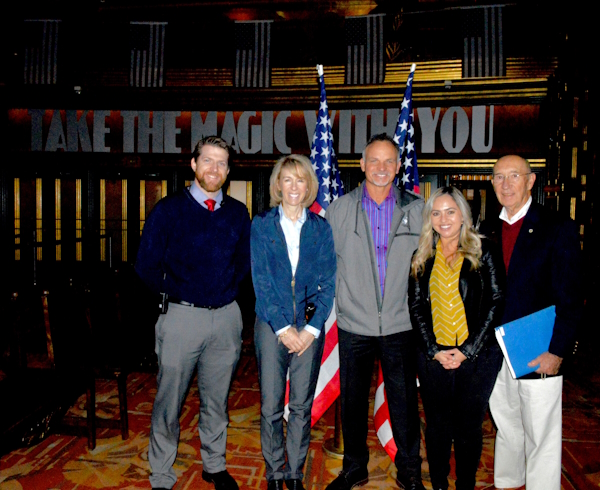Team Effort honors Vets and commemorates Doolittle Tokyo Raiders Day
By Larry Freeman
A company size squad of twelve Yountville California Veterans, Home members, flanked by a platoon of Vets from The Alameda Elks Club, were treated to a special screening of “Thirty Seconds Over Tokyo” on the April 18 anniversary of the Tokyo Raiders’ bombing of Japan, the first such strike after Pearl Harbor.
Kyle Connor, owner of Alameda Theatres, embraced the idea last February after an Alamedan suggested the prospect to him, and set the stage for take off, putting his ‘all hands on deck, ’ go to manager, Allison Shannon in charge of their end.
She booked the classic film, starring Spencer Tracy as Lt. Col. James Doolittle famed Alameda war hero, for a private showing at 9:30 a.m. on raid day.


The special event at the theatre added to Alameda’s ties to the top secret mission that formally began here as 16 B-25 long range bombers were craned onto the original USS Hornet aircraft carrier on March 31 and April 1, 1942 from the former base’s Pier 2.
Tethered to the 500-foot deck, the planes remained static until they launched off of the Hornet’s deck seventeen days later in a feat that had been deemed aerodynamically impossible.
The 134 members aboard the planes carried out the bombings of industrial targets in Tokyo, Yokosuka, Yokohama, Kobe, and Nagoya in what was designed as a one way mission.
The last Doolittle Raid survivor, Mr. Cole, who died in at the age of 103 recalled that the unsuspecting Japanese on the ground , never imagining that long range bombers could hit them from a ship , saw the planes and thought they were from their air force. “People on the ground waved to us. We could see the moat, the Imperial Palace and downtown Tokyo.”
The bombs that hit their targets, made them realize otherwise.
Though the bombings wrought minimal physical damage, the psychological blow to Japan was enormous and a precursor to horrendous, multiple mass fire bombings of Japanese cities, involving over 1,000 planes at a time, would wreak mass destruction in 1945.
While the Doolittle planes narrowly achieved the perilous feat of taking off from the Hornet’s deck to deliver their loads, they could not turn around to land on the short space of the carrier, forcing them to try to touch down in non Japanese occupied territory in China, where secret landing strips had been constructed.
Low on fuel, the planes would not make it to their next objective.
Fifteen of the planes crash-landed in Japanese-occupied territory or ditched off the Chinese coast, and one plane flew on to the Soviet Union, at that time an ally of the U.S.
Three crewmembers perished in crash landings or while parachuting.
The Japanese took eight others prisoner. Of those, three were executed, another died of disease and starvation in captivity, and four survived more than three years of solitary confinement and brutality.
Still, 69 of the men in the raid survived to live another day, underscoring the bravery and daring-do of many a combat vet.
Yountville Vet, Carl Brooks, an airman once based at Vandenberg Air Force base, showed empathy for the raiders, as he spoke of the film’s many intense, high risk moments, which included flying B-25 bombers as low as 30 feet above the sea and skimming over tree tops and mountain peaks en route to their targets.
“It was scary,” said Brooks.
“All of this is very impressive,” he added, referring to the logistics of an early morning trek to Alameda from Yountville, the free film and a complementary ceremonial lunch hosted by the Alameda Elks Club.


Nick Pereira, Chairman of the Vets Committee of the Elks, and a former Marine Lt. Colonel who served for 25 years, including two tours of duty in Vietnam, was contacted by Vets Home Recreational Therapist and ‘outings coordinator’ Crystal Heatherington to insure there would be mission accomplished.
Pereira got approximately 30 Elks Vets to participate in the event and set up the lunch and speech event at their private club bar and dining room.
“As long as these Vets are with us, the Brotherhood Paternal of Elks will never forget them,” said Pereira, who also spearheads annual Elk hosted events as fishing trips, barbeques and Thanksgiving day dinners for the Yountville Vets.
“We have a 50 year relationship with Yountville,” he said with pride.
Hosting his part of the event was also “kind of an excuse to get a free movie for Elks Vets,” he confided.
Alameda Theatres’ contribution in the honoring was inspired by a deep community sense of mission that is part of Alameda Theater’s DNA.
“Anything that we can do to reach out and provide creative events for the community is our philosophy, “ said Connor in capsulizing part of the Alameda Theatre’s ethos of giving back to others .
Connor felt a sense of duty “to do this with the Vets, especially after what occurred . My motive was to give them a little something to take their minds off of it, and recreate an historical experience of showing a film from the time exactly the way it would have been in the ‘40’s,” he said.
Shannon, who spent the better part of her day with the Vets said, “No amount of free popcorn or movies can say ‘Thank You’ enough to these veterans. Meeting them today was my honor and I plan to see them again next year.”
